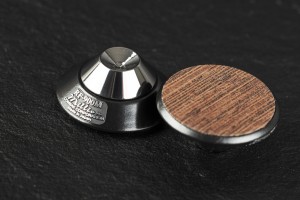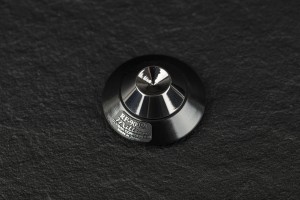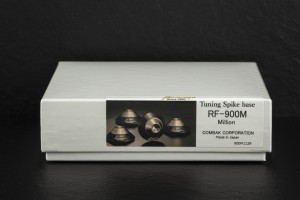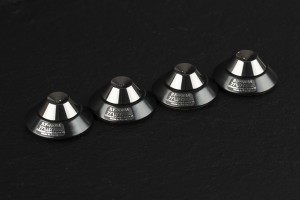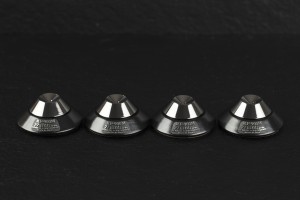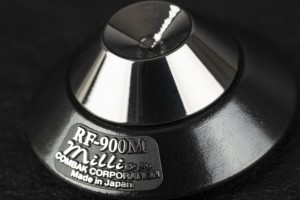Can tiny, little spike bases make an actual difference in a complex audio system? I’d already known from experience that such accessories could help to fine-tune the sound. One of the true master creators of such products is Mr. Kazuo Kiuchi from Combak Corporation. In this review I’ll try to answer if and what exactly his Harmonix RF-900M Million spike bases can do for your setup.
Introduction
There are certain stages of being an audiophile. There is the initial enthusiasm, the discovery phase, if you will when one finds out that her or his favorite music can sound so much better when played using a good audio system. This phase is accompanied by a lack of experience that more often than not leads to spending a lot of money without achieving desired sonic effects. It seems easy – all you have to do is to read dozens of reviews and listen to pieces of advice given by other audiophiles (if they are people one knows personally they may be of value, but those by anonymous audio forum users often aren’t worth much) and buy „the best components” one can afford. Easy, right? Not quite. Not even when one copies the full setup of someone else, as there is a huge factor of room acoustics and size, and some other factors that do affect the sound.
The whole point, whether one just starts their adventure in the audiophile world, or is already an advanced or experienced high-end sound aficionado, is that only careful selection of each component, as they all need to work together in harmony, springs proper results. Newbies though, often only after the fact, realize that buying some set of components even if each of them separately is „the best in its class”, or even one that sounds great in some showroom, does not guarantee satisfying results. Once that happens they move to the impulsive phase and start to (sometimes chaotically) replace amplifiers, speakers, sources, and cables with others spending even more money. Some of the purchases „improve sound”, and some others change its character without actually making it better, yet still many of them don’t last long in the systems. And the story goes on and on.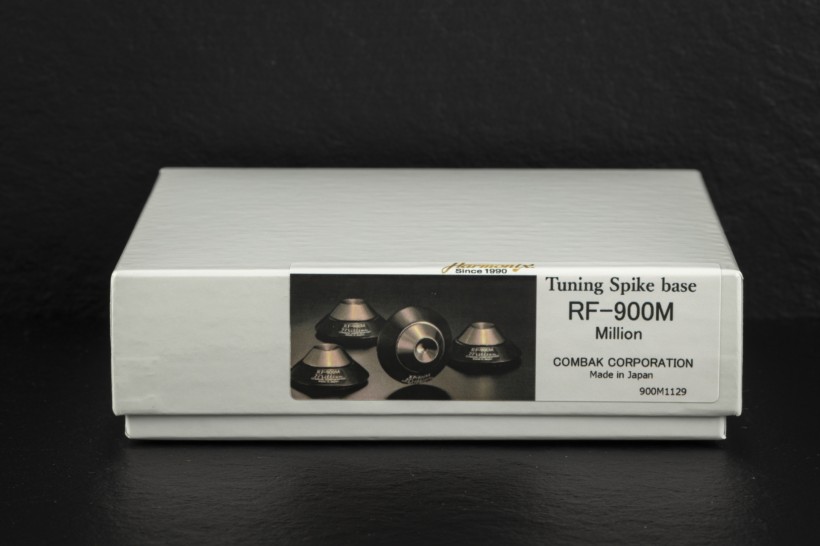
So yes, being an audiophile is sort of a learning curve. One that, to be honest, keeps the audio industry’s wheels turning. My advice – in audio rush and impulses are bad advisers (same as random, all-knowing forum users). It takes time and patience, and not necessarily tons of money, to build a really good-sounding system, one that offers a truly satisfying musical experience. Keep listening, discovering, and learning, and don’t make rush decisions. It will pay off. Also, once you get there you will become an expert at least on your own setup. It will make it easier to find efficient ways to improve its performance.
And now a twist… Having said all that, let me make it clear – this particular review is not for the newbies, not for those who try to find a way to „save” the money they already spent, but rather for seasoned audiophiles who have left the initial and impulsive phases long behind. It is for those who had already meticulously built their setups and are happy (!) with them. Still, as every audiophile, you probably keep looking for ways to make the sound even better, and more satisfying, even if only by a little bit. That’s where products such as the tuning spike bases (and other accessories) from Mr. Kiuchi, or in this case Harmonix RF-900M Million, come in. They may help you to dot the „i” and cross the „t”.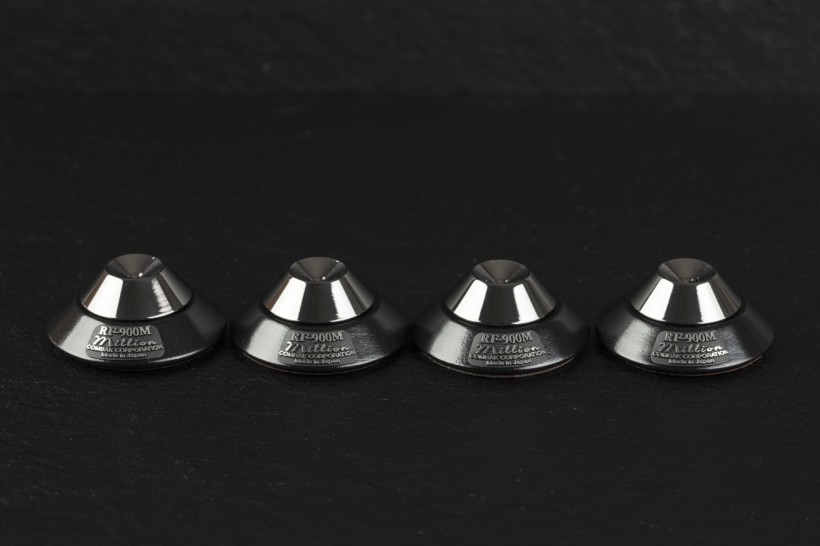
Design and features
As the name suggests, RF-900M are bases or pads one places under spikes. Spikes that speaker or other audio components are placed on, to be exact. Mr. Kiuchi is a renowned and highly regarded figure in the audiophile world. Many of us had a chance to experience an excellent performance of his electronics, speakers, and cables, as well as an impact on the sound that his numerous tuning accessories offer. Some may not even know it, and others have even more reasons to appreciate Mr. Kiuchi’s achievements, but he is also one of the men responsible for the famous XRCD format. In other words, the hero of this story has been working for years on both sides of the proverbial glass – in the recording and in the audio industry. I hope I don’t even have to add, that he is a huge music lover himself.
While designing and developing almost all types of audio components, that is amplifiers, CD Players, speakers, and cables is not that surprising, adding all the anti-vibrations and tuning products to the mix may seem so, at least for some, as these are usually offered by specialized companies. Kiuchi-san though, believes in a holistic approach to audio playback in which all the elements matter, where even tiny details may improve the overall performance quality. As he said himself in one of the interviews, he studied resonances and their effect on the sound of musical instruments for more than 30 years and learned a lot about sound reproduction in the process.
All this knowledge and experience he gained over the years he later used while developing his products, both the „regular” audio components, and all the tuning accessories. The job of each of them is to make the sound better, more believable, more true, and more natural. One of them is the Harmonix RF-900M Million that I am reviewing. If you never talked to professional musicians you may even not realize that they use various accessories for their instruments to not necessarily improve (which doesn’t exclude the possibility!), but surely to tune their sound. That’s what Harmonix products, including the tested spike bases, are intended to do for you and your system. They will allow you to „fine-tune” the sound of the audio component they are used with. In this case, it means allowing them to perform at their best, eliminating restricting factors (resonances and vibrations). That is also why the lineup proposed by the Japanese company is quite large so that one could choose the product that serves one’s needs best.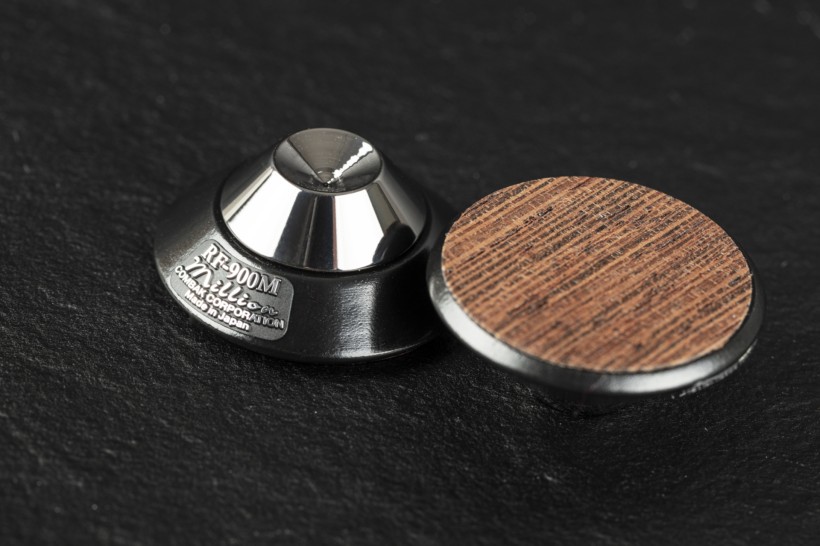
As one reads in the leaflet accompanying RF-900M, they are handmade by the maestro himself of wood and metal. Both materials were carefully selected for their ability to „transform and balance resonances”. That is actually the goal of each of Kiuchi-san’s tuning accessories. After all, the sound is vibrations, and it’s transferred through vibrations of air particles from instruments or speakers to our ears (or microphone when recording). So any additional, unwanted vibration, and remember that not only everything around us resonates, but also vibrations from one source are transferred to the other ones in its vicinity, is harmful to the sound as it is causing some sort of distortion. When distortion is introduced to the sound it loses its naturalness and that’s what we like to avoid, don’t we?
For years Mr. Kiuchi has been developing accessories that combine materials of various own resonance frequencies which allows them to enhance the performance of audio components placed (usually) on them. Like in most cases, the designer doesn’t share his hard-earned know-how, his secrets. So we don’t know what type of metal and wood was used. All one can see is that the lower part is made of wood, and the one that actually hosts a spike, is made of metal. This makes sense – spikes are usually made of metal so a wooden bed would be quickly damaged by a sharp tip. The softer wood, on the other hand, is a better material for direct interaction with a surface, floor/platform/rack, as it won’t damage it.
In the aforementioned leaflet one can read that the RF-900M can be used alone or in combination with other Harmonix products so that, through synergy effect, they could even further enhance the performance of one’s system. For example, one may choose Harmonix’s own spikes, REI-168, and combine them with RF-900M. Taking things even further, one can place the latter on top of additional TU-333EX pads. Customers are advised to take matters into their own hands and experiment with their setups in search of a solution optimized for their particular setup/environment.
They can also ask the maestro for advice. His huge experience allows him to suggest the best solution based on a list of components in the system even if he can’t listen to the particular setup himself. Yet, when given a chance, Kiuchi-san is able to significantly improve performance even of an already good-sounding system by suggesting proper tuning accessories. I witnessed it a few times when he visited Audio Video Show in Warsaw and his final touches to already really good-sounding setups prepared by the experienced distributor always produced welcomed results. Sometimes all it took was swapping places between already used accessories, sometimes it required adding some more.
For this test though, I received two sets, four pieces each, of the Harmonix RF-900M Million alone. They are quite small with a maximum diameter of 32mm and a height of only 13mm (the top rim of the spike’s bed). The quality of make and finish, and the aesthetic beauty resulting from them are stunning. It’s a shame that after placing them under speakers/components one probably won’t even see them anymore. Before you try them out yourself remember that the maximum recommended load for a set is around 80kg. If you have even heavier speakers or components you want to fine-tune using Harmonix products you should select another spike base from the lineup, which is better suited for a more significant load.
Sound
When the Polish distributor, Audio Atelier, contacted me proposing RF-900M Million for a review I had to think hard and long about how would I even conduct such a test. The point is that none of my two pairs of speakers feature spikes (and I wouldn’t b able to add any even if I wanted to) so these tuning bases would be useless for them. Then I realized that I could place my DAC, LampizatOr Pacific, or ESE Lab phonostage on spikes and use RF-900M under them, although that would be sort of a forced test, as I don’t use spikes for my phonostage, and I use Graphite Audio cones for Pacific DAC, but these are made of special material that works best alone. And then the distributor offered to deliver Xavian Aria for another review at the same time (you can find the Polish version HERE). These are stand-mount loudspeakers and since I have the excellent ALPINE-line stands from Vertico line at my disposal, and they feature spikes on both ends (at the very bottom supporting the whole stand, and also on the top plate, directly under speakers) I knew I could use them for this test too. After getting to know them well, that is.
That’s actually how I performed the assessment. First I placed speakers directly on reversed Harmonix bases (as spikes on the top platform point up not down), and then the whole stands on RF-900M (replacing standard metal bases). Admittedly, the former way of using RF-900M may be a little unorthodox but… it worked quite well. Before we get to the specifics let me emphasize once more – the tested Harmonix product is to be used to fine-tune/improve the already good-sounding setup, and not to introduce some groundbreaking changes to its performance or to magically transform a poor one into a great one – it doesn’t work this way! So all the changes I will describe are actually rather small, some even subtle. Yet, for those who know the sound of their system like the palm of their hand, in many cases, they may be significant enough to make them worth the asking price as going back to the sound without RF-900M may be too painful.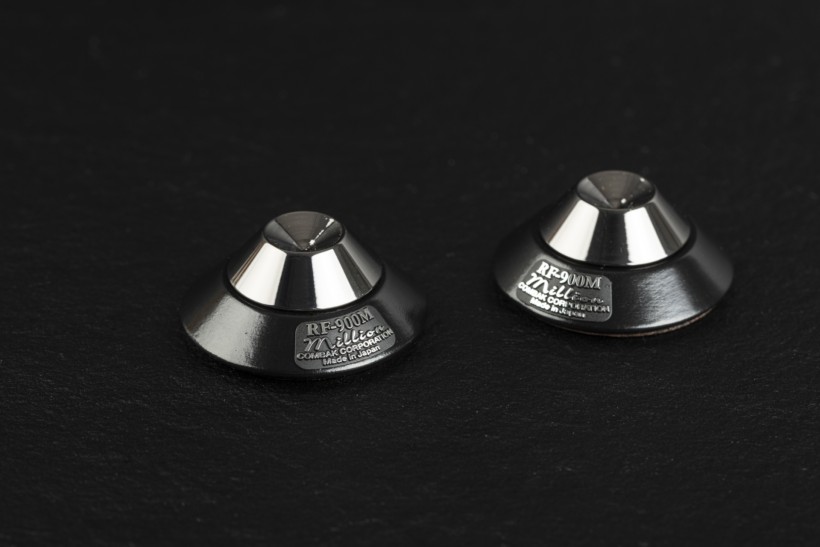
The first impression (with reversed bases directly under the speakers) was that of an even bit deeper soundstage. I was listening to the Cafe Zimmermann interpretation of J.S. Bach music („The Imaginary Music Book of J.S. Bach”) recorded in a church in Mulhouse, France. It seemed to me that the RF-900M allowed the speakers to even better reproduce the ambiance of the great hall and improved the imaging and focus of the sound of each instrument. What followed was a greater clarity of the sound, a better insight, if you will, into the intricacies of the performance, and even greater transparency that made it easier to study each performance separately, to uncover tiny details and subtleties.
Taking the RF-900M later out from under the speakers didn’t break my heart, so to speak, but once knowing the sound achieved with them, the performance without seemed just a little bit less satisfying. It wasn’t actually much worse, I didn’t really feel that there was something significant missing. It was more about this nagging thought, that with Harmonix RF-900M Million the performance would be a touch more natural and realistic, that I could hear a little more with them, or in other words, that the presentation would be more accurate and more natural.
Importantly, while adding these Harmonix accessories made it easier to reach for tiny details, and improved their clarity, the performance as a whole remained beautifully coherent, natural, and had this beautiful flow, same as without them. If anything, the flow was even smoother and the overall impression of being a part of the musical event presented in front of me was even a bit more convincing. In other words, RF-900M did not change the overall character of the presentation but only improved or fine-tuned some of its elements making it more „real”, and more „present”. The change was subtle but welcomed as the sound became a touch more refined, and richer, offering a touch more of that „here and now” feeling.
Next, I removed the Harmonic RF-900M Million completely for a while, trying to get used back to the sound without them, that I’d known before. It took me a while but finally, I almost forgot about the improvement brought in by Japanese accessories. That’s when I put them under the whole ALPINE-line stands where they replaced the original, larger, metal-only spike bases. This approach made their influence on the sound more prominent, and easier to spot.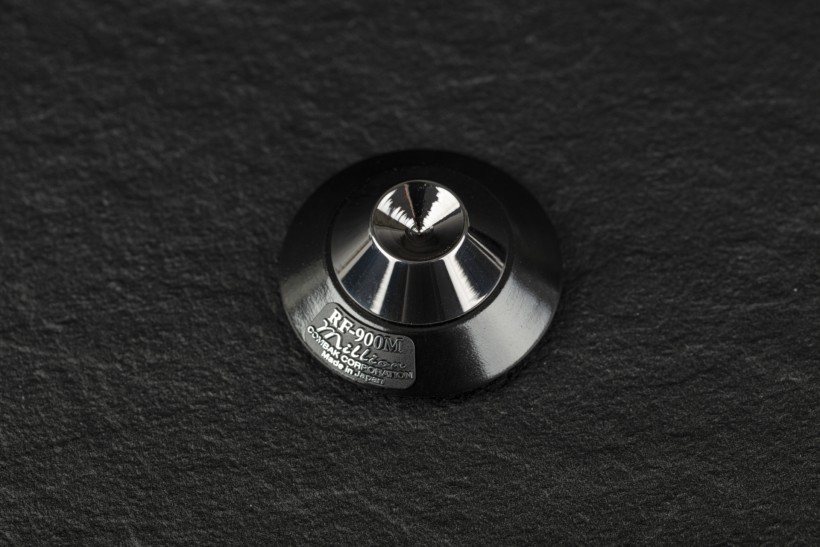
This time the spatial aspect of the presentation, although also improved, wasn’t the first thing that caught my ear. With the original spike bases, Xavian speakers sounded (in comparison!) more direct, and more forward (emphasize on „more” as they didn’t really sound forward). With the Harmonix ones, the sound became more relaxed, slightly laid back, and less forward (in comparison!). I guess, one could call the presentation „softer” or „gentler” but it wasn’t really the case as, for example, Spyro Gyra’s „Fast Forward” album proved quickly. The really tight, fast beat did not soften one bit, and the brass instruments were as crisp as ever, and, I thought, even a little bit more resolving and sounded even more open. Maybe only the midrange, say saxophone, sounded slightly richer, more saturated, and deeper, hence projecting the ‘softer’ and ‘warmer’ overall impression. It doesn’t mean though, that it was too soft, that its sound was colored – it wasn’t! It, simply put, sounded more natural with its timbre deepened and texture more detailed.
What improved with this use of the Harmonix bases under the stands was also the clarity of the presentation. It became a bit more orderly, more focused, so everything had an even more precisely described place and form on the soundstage, and in the mix. It was true even despite the fact that now I perceived the performance more as a coherent, smooth whole with the sounds of individual instruments intertwining and interacting more closely than before, and less as several instruments performing one next to the other, which reminded me even more of a live performance. It’s not that without RF-900M Million I had several separate performances, but that with tested products it became even more cohesive, more live-like.
The features that audiophiles are usually after, I mean separation, differentiation, and precise imaging, are not really part of how one perceives live music when participating in a concert. Hence Harmonix RF-900M’s influence on performance was so unique – there was a touch better clarity and transparency, higher precision, and better insight into the deeper layers of the recording, and yet overall they ensured an even more ‘cohesive’ way of presenting music, more live-like in this regard. Also because it seemed to me that energy transfer between musicians and listeners improved a little. And the energy level is what makes live performance superior to even the best recordings.
To be clear, by more live-like I mean more like acoustic concerts, not huge rock ones. Because when listening later to the, say, AC/DC’s „Live”, or even the black album by Metallica I preferred the original spike bases, as they served more direct, maybe even a bit more aggressive (at least in comparison), and less refined or in other words more ‘raw’ presentation that suited this genre better than the ‘tuned’, more relaxed sound with RF-900M. Although… what happened when using Harmonix also meant that all the imperfections such as a bit too bright and harsh and grainy treble, for example, were slightly less irritating, which was a clear upside of the tested spike bases in rock and metal, and even some pop music. So ultimately, the choice is yours. It will depend on the system, personal preferences, and music choices, although, in general, the higher quality recordings should sound better with Harmonix RF-900M. You can find out whether Harmonix RF-900M Million is a product for you only if you try it out.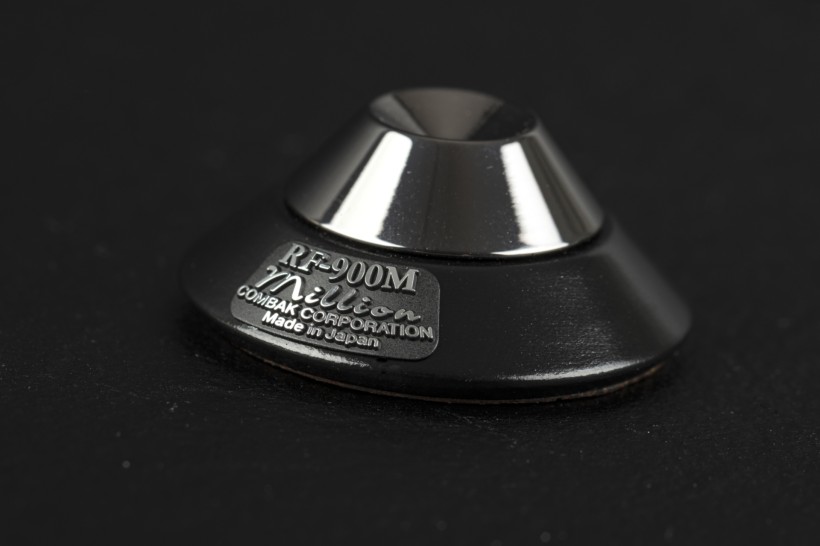
Summary
If you’re hoping for a miracle, for Harmonix RF-900M Million to „fix” what doesn’t work in your setup and turn a poor sound into a great one, you’ll most likely be disappointed. As I’ve mentioned before, this is a „tuning” accessory, something that can improve performance a little but only an already good one! It is one of the last investments your system should need after everything else is already well-matched. Once every other aspect is taken care of, you should reach for the Harmonix spike bases (and possibly other tuning products from their lineup) and check whether they can improve or fine-tune an already very good sound. Because that’s their job – to turn a very good or even great sound into an even bit greater one by revealing the setup’s full potential. I loved what they did for not-very-expensive Xavian Aria speakers that were paired with significantly more expensive components (than themselves). So I can only imagine what Harmonix RF-900M Million could do for even more expensive speakers or components.
There is no magic to it, it’s all about tuning resonances that influence what you hear from your speakers. If you look for ways to get an even more natural, more realistic, more relaxing, and more satisfying performance give Harmonix RF900M Million, or other Harmonix accessories for that matter, a try. They look great and their subtle yet hard-to-live-without-once-you-get-the-taste influence on the performance may be what you need to fully enjoy the music. Don’t take my word for it, but try them yourselves! Kudos to Kiuchi-san for yet another “little wonder” that makes a very good system sound even better and listening to music even more pleasant and satisfying.
Price (when reviewed):
- Harmonix RF-900M: 1.100 EUR / set of 4 pieces
Manufacturer: COMBAK CORPORATION
Distributor: AUDIO ATELIER
Associated equipment:
- Digital source: a custom passive server with WIN10, Roon, Fidelizer Pro 7.10, JCAT NET XE, and JCAT USB XE cards with FERRUM HYPSOS Signature power supply, KECES P8 (mono) linear power supply for the server, JCAT USB Isolator
- D/A Converter: LampizatOr Pacific 2 +Ideon Audio 3R Master Time (USB signal regenerator)
- Analog front end: J.Sikora Standard MAX turntable, J.Sikora KV12 tonearm, J.Sikora KV12 MAX tonearm, AirTight PC-3, phono stages: Grandinote Celio MK IV, ESE Lab Nibiru V 5.
- Power amplifiers: GrandiNote Shinai, Circle Labs M200, Art Audio Symphony II (modified)
- Preamplifier: Circle Labs P300
- Loudspeakers: GrandiNote MACH4, Ubiq Audio Model ONE Duelund Edition.
- Interconnects: Bastanis Imperial x2, Soyaton Benchmark, Hijiri Million, Hijiri HCI-20, TelluriumQ Ultra Black, KBL Sound Zodiac XLR, David Laboga Expression Emerald USB, David Laboga Digital Sound Wave Sapphire Ethernet
- Speaker cables: Soyaton Benchmark
- Power cables: LessLoss DFPC Signature, Gigawatt LC-3
- Power: Gigawatt PF-2 MK2 and Gigawatt PC-3 SE Evo+; a custom power line with Gigawatt LC-Y in-wall cable; Gigawatt G-044 Schuko and Furutech FT-SWS-D (R)
- Network: Silent Angel Bonn N8 + Silent Angel Forester F1 + optical LAN isolator
- Racks: Base VI, Rogoz Audio 3RP3/BBS
- Anti-vibration accessories: ROGOZ-AUDIO SMO40 and CPPB16 platforms and ROGOZ AUDIO BW40MKII feet, Franc Accessories Ceramic Disc Slim Feet and Wood Block Platform, Graphite Audio CIS-35 and IC-35




